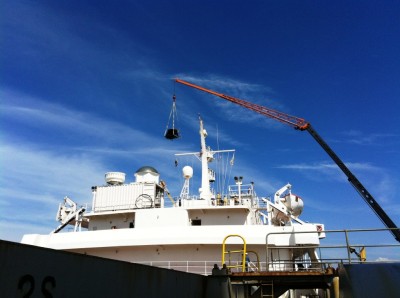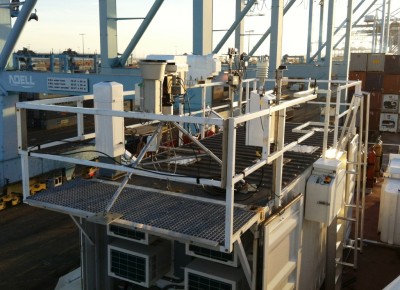Ahoy! It’s MAGIC in the Pacific
Published: 1 October 2012

All aboard! And by “all” we mean the more than two dozen atmospheric research instruments recently installed on the Horizon Spirit container ship. Through funding from the Department of Energy’s ARM Climate Research Facility, these instruments are obtaining measurements from the sky above the ship as it routinely transits between California and Hawaii. Scientists will use these data to study how cloud systems transition from cumulus to stratocumulus along this route of the Pacific Ocean. Due to lack of data, computer models currently have difficulty simulating these cloud processes, which play an important part in the global climate system.
The Marine ARM GPCI Investigation of Clouds, or MAGIC, will give researchers the data they need to improve these models, leading to better simulations of Earth’s climate system. The acronym GPCI refers to the study comparing how different models simulate cloud processes in the Pacific. Led by Ernie Lewis, principal investigator from DOE’s Brookhaven National Laboratory, a team of scientists will take rotations onboard the ship to monitor the data and observe conditions in real time. For more information, see the Brookhaven press release.
A Sea Change for the ARM Mobile Facility
This ocean-going campaign is the first marine deployment of an ARM Mobile Facility (AMF)—there are currently two AMFs, with a third on the way. Operated by Argonne National Laboratory, the second unit, called AMF2, was first deployed throughout winter in Steamboat Springs, Colorado. It then moved to Gan Island in the Maldives, a small island chain in the Indian Ocean, until early 2012.
Since its return to the United States, AMF2 has been undergoing an extensive reconfiguration, with instruments getting calibrated, updated, and modified for MAGIC. To endure the strenuous sea voyage, many of the instruments had to be “hardened” to withstand the corrosive environment of sea salt, not to mention reinforcements for operating on an ocean vessel.
With deployment space on the Horizon Spirit at a minimum, the AMF2 team constructed new mounts for many instruments, moving them up off the ground onto containers. One container was reconfigured with custom shocks and mounts for the Ka-band ARM zenith radar and radar wind profiler antennas on its roof. A new stabilized platform was also developed to maintain the marine W-band ARM cloud radar in a steady vertical orientation while moving through the ocean.

“This is an exciting, cutting-edge deployment, requiring many new connections between the AMF2 instruments and data collection systems,” said Nicki Hickmon, AMF2 Technical Operations from Argonne “Lots of people have put a lot of hard work into this, and it’s great to see it all come together.”
Good News on the Horizon
When looking for a vessel that could meet their science objectives, the MAGIC science team identified the Horizon Spirit, which transits their region of interest. They also estimated that the footprint on the ship’s bridge could accommodate the AMF2 space requirements, and indeed, the unique bridge deck on the Horizon Spirit provided more space than most cargo vessels.
With the understanding that AMF2 operations could not affect cargo operations, Horizon Lines graciously agreed to modifications on the bridge deck for stiffeners and welded mounting systems and sockets to secure the AMF2 hardware. All deck modifications were designed by a marine architect, approved by the American Bureau of Shipping, and then inspected and signed off on by the ABS. All modifications will be remediated at the end of the campaign.
“The Horizon Spirit is a ship of opportunity granting us the privilege of riding along with their cargo operations,” said Hickmon. “Everyone at Horizon has been very accommodating, particularly the captains and crew, who are the feet-on-the-ground giving us access to the ship.”
Except for the vessel’s 3-month dry-dock period between late February and early May 2012, the AMF2 will operate continuously through September 2013. In addition to the MAGIC science team members, at least two AMF2 technicians will be aboard the ship to monitor and maintain the instruments. More information about the MAGIC campaign, including links to more photos and a “ship locator” can be found on the AMF2 deployment web page.
The ARM Climate Research Facility is a DOE Office of Science user facility. The ARM Facility is operated by nine DOE national laboratories, including .
Keep up with the Atmospheric Observer
Updates on ARM news, events, and opportunities delivered to your inbox
ARM User Profile
ARM welcomes users from all institutions and nations. A free ARM user account is needed to access ARM data.


















